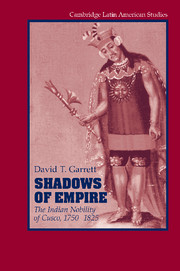In October, 1797, the indios principales of the Andean pueblo of Muñani appealed to the royal court in Cusco to depose their governor, or cacica, Doña María Teresa Choquehuanca. Not challenging hereditary Choquehuanca rule, they instead focused on María Teresa's incompetence and her sex, complaining of “the miseries that we have suffered with [her] inappropriate entry into the cacicazgo,” adding that “on account of her distinct sex she should by justice be deposed, because she is not worthy of so estimable an office.” That office was central to the indigenous politics of colonial Peru, the legal and administrative ordering of which placed most of the Indian population in relatively autonomous, land-owning “pueblos de indios” over which the cacique, responsible for collecting the crown's tribute and maintaining order, presided as something between a chief and a lord. As the village leaders in a parallel, popular tradition that reserved its authority for men, Muñani's principales asserted that this bastion of elite indigenous authority ought not be held by a woman. But they made clear that it sometimes was: María Teresa had governed Muñani for five years. Nor was she alone. Cacicas governed pueblos and ayllus throughout the Andes, and it was quite common for the husbands of cacical heiresses to rule in their names.
